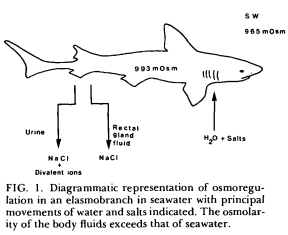We may take it for granted that a fish, a seaweed, or clams are not too salty to eat, although the sea around them is salty. I know about the existence of a mechanism which prevents their body from becoming as salty as the sea itself, but this raises an important evolutionary question.
As life evolved from single-celled organisms, those organisms started as very simple cells with the bare essential metabolic functions. Possibly their DNA had no nucleus, and obviously they could not (yet) balance the salts within their body. In theory, this would say that their metabolism should have evolved to function is a salty environment. Yet, we see that this is not the case of modern organisms.
Which of the following scenarios describe the evolution of marine creatures with no excess salts in their body?
1- Metabolism may have started in a salty environment, cells have later "discovered" that less salt makes metabolism more efficient, and therefore the energy expended to clear-out the salts is worth the effort.
2- The time it took for salts to accumulate in the seas allowed marine creatures to adjust to a gradual increase in salinity.
3- Fresh water bodies (Rivers and lakes) are better suited for life to evolve. Eventually, some of the rivers will pour into the sea with all their content, including any living thing facing the challenges of salty sea water. This article mentions "ponds", but larger bodies of water are a better means of transporting those organisms to the sea.
What do we know about the timeline of changes in oceans salinity vs. timeline of evolution? Do we have fossil records that show the salinity content of the organisms?

